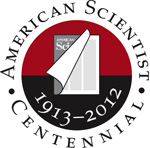
This Article From Issue
January-February 2012
Volume 100, Number 1
Page 2
DOI: 10.1511/2012.94.2

Welcome to Volume 100! Quite frankly, I am abashed. I feel the weight of responsibility for such an august publication often enough as it is, and the centennial only serves to focus that pressure. At the same time, it is a joyous occasion. Not many magazines reach 100. Let me tell you some of what we have in store for the celebration.
In this issue, you will find features looking back at two of American Scientist’s many strengths. Below, we have picked out a selection of our favorite covers over the years. This is necessarily limited for the most part to those from 1970 forward, as that was the year the magazine adopted its current format. Prior to that, covers were tables of contents, as you can see on the example from 1942, the first to carry the name American Scientist. We have also tried to include examples of the various iterations of the logo—or masthead as we say in the trade. Farther back, we excerpt a Classic B. F. Skinner piece from 1957. I say “excerpt” because the original was 29 pages long. Immediately following, Stephen Ledoux recaps the 55 years that followed in behavioral research, during which time behaviorology, as he and many of his colleagues call it, struggled to establish itself as an independent entity.
In subsequent issues we will be looking at some of the longer-lasting magazine features. “The Scientist’s Book Shelf,” for example, dates to 1943, although you may notice that the word forms have morphed a bit since then. “Marginalia,” too, has a long history and also dates to 1943. Ecologist G. Evelyn Hutchinson was its long-term author, penning most entries until he left the position in early 1955.
I leave the last word on American Scientist history to Alex McKenzie, who was the first to send in a suggestion for a favorite article, as requested in my last column. McKenzie writes, “The one article I have always remembered was an article about plate tectonics published in the 1960s (or maybe early ‘70s). It was the first I had ever heard of this theory, and within a few years it was widely accepted.” He refers to Dan P. McKenzie’s July–August 1972 article “Plate Tectonics and Seafloor Spreading.” Perhaps it was the author’s last name that caught Alex’s eye, but he certainly knew my weakness. I was a geology student in the mid-1960s, when plate tectonics was putting down roots. I had found other callings by the time McKenzie began to publish widely, but I was certainly familiar with the writings of geophysicist J. Tuzo Wilson on the subject. Thanks, Alex, for calling my attention to the article.
Rest assured, however, that we won’t overplay the history bit. There’s plenty of vital new science to relate. Robert Pringle is an ecologist who takes a unique approach to studying disturbed systems. In “How To Be Manipulative,” he describes how he isolates (or uses isolated) ecosystems and introduces perturbations. Comparing his interventions to environmental recovery projects, he calls into question just what restoration ecology is. After all, evolution doesn’t have a reverse gear. In “Artificial Noses,” David Walt, Shannon Stitzel and Matthew Aernecke explore what it takes to mimic the exquisitely sensitive mammalian olfactory system. Then Douglas Larson returns to the scene of the beginning of his career as a limnologist in 1964. Back then, Devils Lake, North Dakota, covered about 80 square kilometers. Today, as he relates in “Runaway Devils Lake,” it has inundated 815 square kilometers and continues to grow. Therein lie many lessons for what we may face with climate change.
American Scientist Comments and Discussion
To discuss our articles or comment on them, please share them and tag American Scientist on social media platforms. Here are links to our profiles on Twitter, Facebook, and LinkedIn.
If we re-share your post, we will moderate comments/discussion following our comments policy.